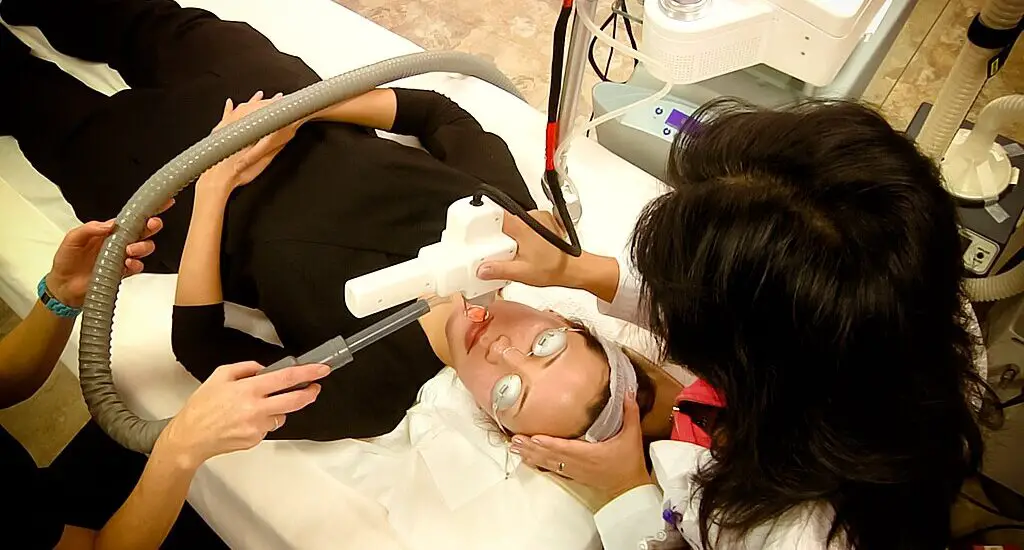If you’ve recently undergone a fractional laser treatment, it’s crucial to understand what to do after fractional laser to achieve the best outcome and minimize any adverse reactions. This in-depth guide covers all the essentials in a straightforward manner.

Table of Contents
What to Do After Fractional Laser: First 24 Hours
The first 24 hours after fractional laser treatment are crucial in setting the stage for the skin’s healing process. It is during this time that the skin is at its most vulnerable state, making it imperative to adhere to specific care guidelines.
Sun Protection
Directly following the procedure, your skin is highly sensitive and prone to damage from the sun. Even a short exposure can cause burns or alter the results of the treatment. It’s vital to stay indoors and away from direct sunlight. If it’s necessary to go outside, wearing a broad-spectrum sunscreen with an SPF of at least 30 is essential, along with protective clothing and a wide-brimmed hat. [Source]
Check out this EltaMD UV Sport Body Sunscreen on Amazon.
Cleansing
The skin will be tender, so washing with a gentle, hydrating cleanser without scrubbing is key. This helps prevent infections and ensures the treated area remains clean without causing further irritation. Pat the skin dry with a soft towel rather than rubbing it.
You can get this La Roche-Posay Toleriane Hydrating Gentle Face Cleanser from Amazon.
Avoid Makeup and Irritants
Chemicals in makeup or certain skincare products can irritate the freshly treated skin. It’s best to give your skin a break and allow it to breathe, avoiding any potential irritants.
What to Do After Fractional Laser: Days 2-7
The days following the initial 24 hours are critical in terms of preventing complications and ensuring optimal healing. The skin will start its recovery process, and specific care steps are necessary.
Continued Sun Protection
As your skin starts to heal, it remains vulnerable to sun damage. Sun exposure at this stage can lead to prolonged redness or hyperpigmentation. Continue to apply sunscreen diligently, reapplying every two hours if you’re outdoors.
Moisturizing
Treated skin may feel dry and tight as it starts to heal. Moisturizing regularly with a non-comedogenic, hydrating lotion like this Amazon-listed Cetaphil Body Moisturizer can alleviate these symptoms, promoting faster healing and preventing flakiness.
Avoid Scratching
The healing skin may itch. However, scratching or picking can disrupt the healing process, potentially causing scars or uneven skin texture. If itchiness becomes bothersome, consult your dermatologist for a suitable soothing lotion or ointment. [Source]
What to Do After Fractional Laser: Week 2 and Beyond
Once you cross the one-week mark, your skin will have undergone significant healing. However, the care doesn’t stop here. Ensuring long-term skin health and maintaining the results of the fractional laser treatment is key.
Reintroducing Skincare
Gradually reintroducing your regular skincare products is essential. Test each product on a small patch of skin to check for any reactions. Hold off on products with active ingredients, like retinoids or acids, until your dermatologist gives the green light.
Consultation
Regular check-ins with your dermatologist can provide insights into your healing progress. They can recommend specific treatments or products tailored to enhance and prolong your results.
Consistent Sun Protection
The treated skin, even after healing, remains more sensitive to the sun. Protecting it from UV damage not only prevents complications but also maintains the results of the treatment.
Check out these other articles…
How Long Does It Take to See Results from Fractional Laser?
How to Take Care of Skin After Fractional Laser: Easy Guide
Does Fractional Laser Tighten Skin? Comprehensive Answer
What to Avoid After Fractional Laser: Comprehensive Guide
How Long Does It Take to Heal from Fractional Laser?
Skin Peeling After Fractional Laser: Comprehensive 411 Guide
Potential Side Effects and How to Address Them
Fractional laser treatments are generally considered safe, but like any medical procedure, there can be side effects. Recognizing and addressing these side effects promptly is critical.
Redness and Swelling: It’s normal for the treated area to exhibit redness and swelling post-procedure. These symptoms are generally short-lived and should subside within a week. Using cold compresses can help reduce swelling and alleviate discomfort. If the redness persists or becomes more intense, it’s crucial to see your dermatologist. [Source]
Blisters or Burns: In rare cases, the treated skin might develop blisters or burns. This can be due to the intensity of the treatment or an unexpected reaction of the skin. It’s essential not to pop or pick at blisters, as this can lead to infection or scarring. Keeping the area clean and applying a prescribed ointment can aid in healing. If you suspect a burn or see large blisters forming, contact your dermatologist immediately.
Hyperpigmentation or Hypopigmentation: Changes in skin color can occur after the treatment. Hyperpigmentation is when the skin darkens, while hypopigmentation refers to lightened patches. Consistent sun protection, along with specific creams or treatments recommended by your dermatologist, can help address and prevent these changes. [Source]
Dryness and Peeling: As the skin heals, you might notice dryness and mild peeling. This is part of the skin’s natural exfoliation and healing process. Regularly moisturizing with a suitable cream will help ease these symptoms. Avoid forcefully peeling off skin flakes, as this can hinder the healing process.
Infection: Though rare, there’s a possibility of the treated area getting infected, especially if aftercare guidelines aren’t followed meticulously. Signs of infection include excessive swelling, yellowish discharge, increased pain, or fever. If you suspect an infection, seek medical attention immediately.

